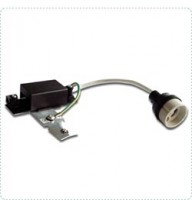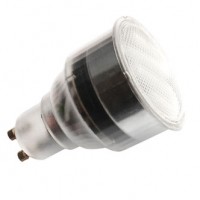After some discussion on power-hungry low-voltage halogen downlights in the comments section of my [We Now Have Solar Power](http://green-change.com/2009/05/18/we-now-have-solar-power/) post, I thought it was high time I did something about them. CFL downlights seemed like the logical replacement.
A while ago I measured that our 50W halogen lights are actually drawing 65W each – the extra 15W is lost in the transformer. So a string of 4 lights uses 260 Watts! We have about 30 of these downlights throughout our house. Ouch!
As part of the [Sustainable Illawarra Super Challenge](http://www.sustainableillawarra.com.au/The-SuperChallenge.html) we’re participating in, we got $100 worth of vouchers for energy-efficient lighting solutions from Cosmo Lighting (Shop 3/9-11 Princes Hwy, Albion Park Rail ph 4257-9111). Serge (the company director) was really helpful, and spent a lot of time showing me the options for converting halogen downlights to something more efficient.
There are three main options for making halogen downlights more efficient:
– **Use lower wattage halogen lamps.** It’s kind of obvious, but I could have replaced some of the 50W halogen lamps with 35W halogen lamps, and saved 15W per downlight. There are new Infra Red Coated (IRC) lamps that claim to give the same light output at 35W as a normal 50W lamp, so I could have even used 20W IRC lamps for some areas and 35W IRCs where the extra brightness is needed. This is an easy thing to do, since no fittings need to be changed, but the IRC lamps cost more and the energy saving is not huge.
– **Use LED lamps.** You can now get LED lamps that fit into the same fittings as halogen downlights, but use as little as 3W. It sounds great, but most transformers designed for halogen lights work best under a 35-50W load. When run at just 3W, their output voltage increases and they’ll greatly shorten the life of your LED lamps. This is not a good thing, as 3W LEDs (equivalent to 20W halogens) cost around $50 each, and 6.5W LEDs (equivalent to 35W halogens) cost over $100 each! To get around this problem, you need to buy and install new transformers specifically designed for LEDs.
– **Convert the fittings to 240V and use Compact Fluorescent CFL downlights.** You can pull out the 12V transformers and wire in GU10 kits, which provide a 240V plug for lamps but use the same downlight fittings to hold the lamp. You can then install 11W or 13W CFL downlights (a 13W CFL is roughly equivalent to a 50W halogen in terms of light output). This option currently gives the best bang for the buck – it uses twice the energy of a 6.5W LED for the same light level, but costs under $10 for the kit plus about $3-10 for the CFL lamp (depending upon brand and brightness).
I was talking to Serge about some of the stuff we’d been doing (and were planning) to reduce our energy consumption, and he really wanted to help me out. In the end he gave me an awesome price on 10x GU10 downlight kits, 6x 11W CFL lamps and 4x 13W CFL lamps.
So today I got up in the roof and changed some fittings over. It’s a pretty simple process, but if you’re not qualified you should get an electrician to do this for you.
I chose our most-used lights for this – 4 in the loungeroom, 4 in the dining room, and 2 in the play room. The dining room is where we need the most light, for when the kids are doing craft etc at the table, so that’s where I put the 13W CFL downlights. I decided not to change anything in the kitchen for now – even though we use those lights a lot, we want it bright in there so you can see what you’re doing, so I didn’t want to risk it for this first trial.
>Tip: Before you get up in the roof, pull the globes out of the fittings you want to convert. This makes it much easier to find the right ones when you’re up in the roof!
Then I just had to wait for nightfall so I could test them out.
The verdict? We’re pretty happy with them. We made the right decision putting the 13W lamps in the dining room. The 11W ones are a bit dimmer – fine for where we put them, but I think I’ll just buy 13W lamps from now on. Like all CFLs, they take a moment to start and another couple of minutes before they reach full brightness.
Compared to the original 4x 50W lamps (totalling 260 Watts including transformer losses), the 4x 11W CFL downlights (totalling 44 Watts) use only 17% of the electricity. I can live with a few minor drawbacks for that kind of savings!
I’m hoping that one day in the not-too-distant future I’ll be able to buy LED lamps for the GU10 fittings at a reasonable price and save even more energy. But until then, the CFL downlights are a workable solution.
It’ll be interesting to see what effect these 10 lights will have on our electricity usage.
Note: CFL downlights contain mercury, a toxic substance – if you install them, make sure you know the procedure to safely clean up a broken CFL.



Comments
11 responses to “Converting Halogen Downlights To CFL Downlights”
Well done Darren. You will notice the difference in just a week I reckon. If you are as crazy as I am with my energy monitoring, you will see a massive reduction in consumption. Best of luck.
Gav
@Gav: I read the meter every morning as I leave for work, keeping a little notepad and pen in the meter box for convenience. Is that the kind of crazy you mean? 🙂 It’s been especially exciting lately having the extra set of figures to record – the solar power generated on the previous day. I’ll post back when I get some results to share.
Darren, I’d changed my home’s lighting system from the fluorescent lamps into LEDs lights since 5 years ago! Honestly, it helped me saved up more than $80 per month and I’m glad that I made up the right decision!
@Wilson: Yep, LEDs are the way of the future. If I was renovating a house now, there’s so much I’d do differently.
Glad to hear you found Cosmo Lighting so helpful Darren, they are really fantastic and very supportive of green options, which a lot of other lighting places aren’t around here.
Isn’t it criminal that halogen down lights were even allowed onto the market in their conventional state… as you say, hopefully the LED’s will come down in price and fit into different fittings soon.
Thanks for providing such a good summary of the different options available now for replacing standard halogens – I’ll definately be referring any enquires about that to your site!
Hope you notice a good decrease on your energy bill.
Cheers,
Ally
http://www.happyearth.com.au
Hi Ally! Cosmo are very knowledgeable, and have a pretty good range of eco options in stock. They have a good demo room out the back, too, where you can see for yourself just how bright the various lights are compared with each other. I like how honest they are, too – where packaging exaggerates claims, they’ll set you straight. For example, some products claim to be as bright as a 50W halogen, but that’s only true because they use a narrower beam angle which doesn’t make them equivalent.
Cosmo will be exhibiting some eco lighting options at the Kiama FutureCare launch on Friday this week, too. We’re very grateful for their support.
Our energy use seems to have come down significantly – I’ll have to check the meter a few more times and get some real figures to share.
All Things Eco Blog Carnival Volume Fifty Three…
Welcome to the June 1st, 2009 edition of All Things Eco.
Be sure to Stumble the posts you like, or submit them to other social bookmarking services. Let’s promote each other, as well as this blog carnival.
It’s June already! Hard to believe…
Siam…
I’m using mostly LED bulbs in my home right now. They’re great for saving on electricity bills!
@GU10: Yes, but with the current cost of LED bulbs, you wouldn’t actually be saving money overall. CFLs are cheap to purchase, and will reduce your power bill by more than their purchase cost within a relatively short timeframe.
I have exactly 100 LV Downlights in my large home. I want to replace at least 30 of the high used rooms with an LED or energy efficient replacement lights but am confused as to the real opportunity to replacement benifits. Looks like each light will cost over $20.00 – buy lots of light electricity for that cost. PS. i have a minum of 4 lights in each room and 12 in the rumpus room.
HELP–
@Roger: That’s a lot of low voltage downlights! You’re right to start with the most used lights/rooms. Just working with rough numbers – a 50W LV downlight will typically draw about 60W (the transformer wastes some as heat). If that light is on for 4 hours per day, it’ll use 0.06 x 4 x 365 = 87 kWh/year. At 20c/kWh, that’s about $17.50 per year.
There are 3 standard alternatives to the 50W halogen:
35W IR halogen – drop in replacement bulb, not very expensive to buy, same light levels as normal 50W halogen, energy savings around 30% ($5/year on above scenario).
15W CFL – requires new light fitting (electricians aren’t cheap!), slightly lower light levels than 50W halogen, bulb should last longer than halogen, energy savings around 75% ($13/year on above scenario).
7W LED – drop in replacement bulb (usually – older halogen transformers may need replacing), expensive to buy, 30% lower light levels than 50W halogen, much longer bulb life (5-10x longer!), energy savings around 88% ($15/year on above scenario).
Given the costs of some of the above options, another thing worth considering is to bite the bullet and redo your lighting completely with pendants. A room with 4x 50W halogen downlights can typically be suitably lit with 2x 25W CFLs, giving around 75% energy savings. It will cost money to have an electrician do this, but if you have lots of downlights the savings could be significant. Every house is different, so it’s hard to know whether this would suit your situation.
It’s probably worth visiting a good lighting shop and asking their advice. Yes, they’ll be trying to sell you their stuff, but they still might come up with some options that make sense. It can’t hurt. Good luck!